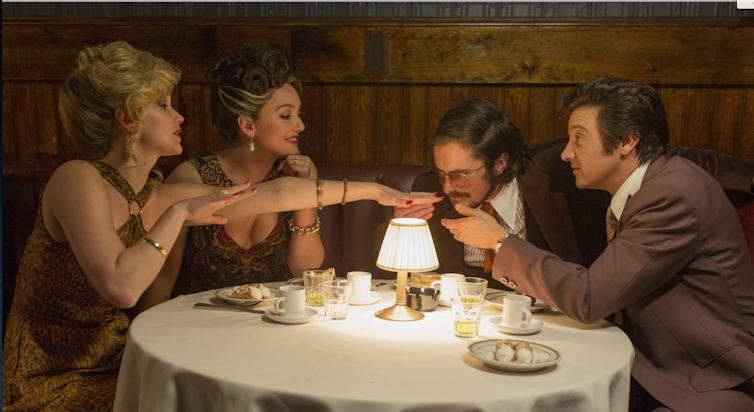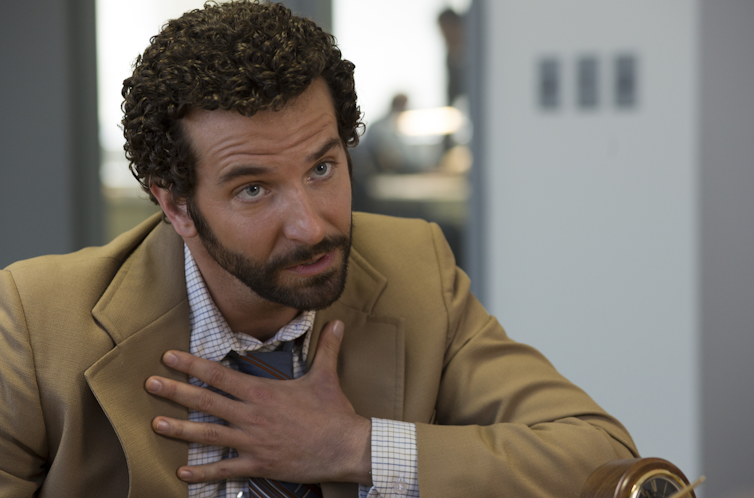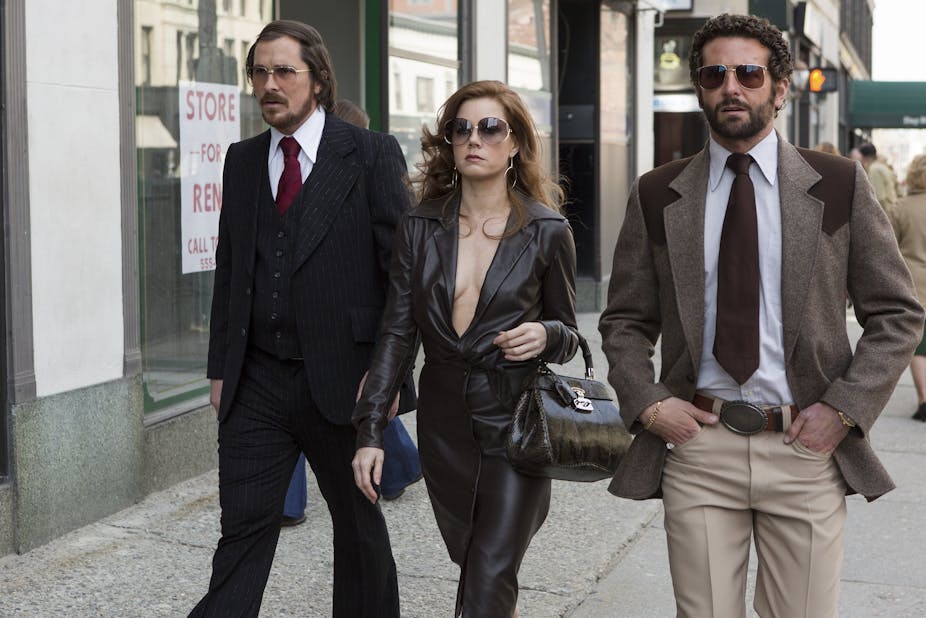“Some of this actually happened.” So reads the non-committal title card that precedes the opening scene of David O’Russell’s sixth feature, American Hustle (2013) – a film nominated for 10 Oscars at the 2014 Academy Awards.
The title card indicates how the bones of American Hustle’s plot lie in the FBI anti-corruption operation known as Abscam that ran between 1978 and 1980. In this highly racist scheme, the FBI enlisted the assistance of a well-known conman in employing fake Arab sheiks to dupe US congressmen and senators into accepting money for various illegal activities. Those officials were later arrested on bribery and conspiracy charges.
Unsurprisingly, O’Russell has opted to gloss over the bureaucratic facts of this operation in favour of a focus on five strong characters in a painstakingly recreated New York and New Jersey of the late 1970s. For numerous commentators the result is too slight an achievement to bear the weight of being the most nominated film in the 2014 Academy Award season.
American Hustle is seen merely as a group of big name stars flaunting their costumed bodies, as College Humor’s Honest Titles for 2014’s Oscar-nominated Movies poster neatly sums up.

But why should such a spectacle not be award-worthy? The Oscars is an institution that values performance above everything, and American Hustle is a film whose very essence lies in the performative. In O’Russell’s hands the Abscam operation becomes an ethical meditation on how to survive in a world where one’s options are limited, and to this end each character reinvents his or her self in a performed role that is founded upon behaving illicitly towards others.
To hustle is to survive, and everyone is hustling someone — whether by assuming an aristocratic British identity to lure desperate people into fake loan agreements (Amy Adams as Sydney Prosser/ Lady Edith Greensly) or by threatening to expose a husband’s illegal operations if he tries to divorce you (Jennifer Lawrence as Rosalyn Rosenfeld).

The drama of the narrative is based on the cracks that start to open up between these brash roles and the “real” humans beneath, and is situated most emphatically in the guilt that central conman Irving Rosenfeld (Christian Bale) feels upon developing a genuine friendship with the New Jersey mayor (Jeremy Renner) who is the main pawn in the FBI operation.
For each character, one persona is constantly visible in another, and the slippage between them casts the film as a strong character piece – more than just a “comedy caper”.
But the real achievement of American Hustle lies in the way this interest with personal transformation and reinvention is matched by the performance of the five lead actors, who all visibly put on their roles as though dressing in drag.
Each plays against type, meaning against the star-image that has been constructed for them on the basis of their appearance in other roles and in extra-textual arenas such as interviews and gossip.
Thus Christian Bale’s slick, restrained image (composed largely in and by his turn as Batman in Christopher Nolan’s Dark Knight trilogy) is wholly subverted in his manifestation of the paunchy, balding and messily candid figure of Irving.

Similarly, Amy Adams gloriously shatters the image of the buttoned-up “good” woman that has enlivened her performances in roles such as Peggy Dodd in The Master (2012) and Julie Powell in Julie & Julia (2009).
As Sydney, Adams brings the quiet strength of these figures to a new and convincing dimension that is intensely racy, desperate and treacherous. And the centrepiece of the film is the masterful rebellion that Jennifer Lawrence achieves against the image of The Hunger Games’ earnest teen warrior Katniss Everdeen. As Rosalyn, Lawrence is sublime – a vampy, bored, hysterical wrecking ball that can and does bring the whole operation of the plot asunder.
The fascination that these characters hold can be illuminated by some of the concepts discussed by various film theorists on acting, stardom and performance.
James Naremore of Indiana University employs the notion of ostensiveness (meaning, broadly, demonstrativeness) to name the degree to which the work and skill of a performance is made visible to the audience. A performance that is obviously crafted and committed – the “great” performance that wins an Oscar – is an ostensive one.

A well-known paradox exists here. If the achievement of an individual performance is traditionally valued in terms of how completely a performer disappears into their role, the perception of this disappearance must inevitably be based upon keeping the performer’s star-image in mind, in order to appreciate how fully it is subordinated to the demands of characterisation. A “good” performance must simultaneously be and not be ostensive.
One common critical position assumes that stardom in this way necessarily precludes a quality performance, for the star can never sufficiently eradicate their recognisable image. This is an assumption that underpins much of the criticism of American Hustle as overrated, incoherent and superficial.
But I see instead a film that maintains a precise balance on this tenuous and mesmerising scale of ostensiveness, with key players that dwell within a liminal register where they show and obscure their performance in subtle and unpredictable rhythms.

As a period piece, the ostensive dimension of performance in American Hustle is matched by its production design, which emphatically foregrounds the aggressive taste of the era. The shock of the style is a constant reminder that nothing about this film is natural.
It enacts the mythic theme of reinvention with the critical distance of every film employing the prefix “American” in its title (American Gigolo [1980], American Beauty [1999], American Psycho [2000]…) — delivering a set piece that showcases not only the performances of its five leads, but the spectacle of performance itself.
See further Oscars 2014 coverage on The Conversation.

